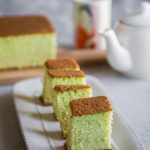
Pandan Honey Kasutera (Nagasaki Castella Cake)
Servings: 10 slices (9 x 5 loaf pan)
Calories: 133kcal
Learn how to make Japanese style old-fashioned sponge cake that is soft, moist, with a nice chewy texture, and with an amazing aroma of pandan and honey.
Print Recipe
Ingredients
- 4 large eggs (room temperature) about 50 grams each without the shell
- 100 g granulated sugar
- 25 g warm milk
- 50 g honey
- 1 tsp pandan essence omit if you want original flavor
- 135 g bread flour I don't recommend all-purpose flour
- ⅛ tsp salt
Instructions
Things to do before you start working on the recipe:
- Preheat oven to 320 F (160 C). If your oven has top and bottom heat, you may want to adjust by lowering temperature by about 20 F /15 C. It is VERY important that the eggs are at room temperature.
- You can use 9 x 5 loaf pan or 7 x 7 inch square pan. Oil the baking pan or use a non-stick spray. Line the bottom and sides with parchment paper. Trim off excess paper. Can I bake without lining the pan with parchment paper? Read my post at the bottom for this.
- Sift the bread flour with salt. This extra steps will aerate the flour, remove lumps so that it's easier to mix into the batter at a later step
- Combine honey with milk and set aside
Beat the eggs:
- Beat the eggs in a stand mixer with a whip attachment on speed 8 for about one minute. Then increase the speed to 10 and add sugar in 3 batches, about 1-minute interval each time. Beat until the mixture is tripled or even quadrupled in volume, thick, and creamy. This may take about 5 minutes over high speed. If you use a hand mixer, this will take much longer. We call this "ribbon stage"
- If you put a toothpick in the batter. It will stand without falling. You can also test the consistency by lifting some of the batter with the whisk and the batter should drop down in trail and remains visible before disappearing into the batter. It is VERY important to beat to ribbon stage. It took me about 5 minutes with stand mixer at speed 10
Incorporating flour mixture and liquid:
- You can stop the mixer and do this manually by hands OR lower the speed of the stand mixer to 2 and add the honey into the batter and let it beat on low speed until combined, about 20 seconds or so
- Add 1/3 of the flour mixture over low speed, then add the next 1/3 until you run out of flour. The flour may not be thoroughly combined and you will still see some on the side of the mixing bowl. Don't worry, don't try to beat until they are combined. Stop the mixer and use a rubber spatula to gently scrape the sides of the bowl and gently fold it into the batter using the swipe down and fold over motion until you no longer see any pockets of flour. Do not overmix
Baking:
- Pour the batter into the prepared pan. It should be only about 3/4 full. You can bake the remaining extra in a smaller pan. Tap the pan on counter 3-4 times to release any large bubbles. Use a skewer or a chopstick to draw a zigzag to pop any large bubbles inside the batter
- Put the pan in a preheated oven, middle rack and bake for 45 minutes or until cake is no longer jiggly and the top is dry to touch and feels bouncy
Cooling down:
- Remove the cake pan from the oven and drop the pan on the counter 2-3 times to minimize shrinkage. Invert the cake upside down on the parchment paper. Wrap a cling plastic wrap around it. You can peel the parchment paper off the cake then wrap with a cling wrap directly. Read my post below on why it's important to cool it upside down the whole time
Age the cake:
- Then let the cake cool down in this postition for 1-2 days. I usually do 2 days at room tempearture. Some people age the cake in the fridge for 1 day. You can do either way
To serve:
- Carefully remove the plastic wrap. Trim the 4 edges and slice with a serrated knife to serve. Japanese castella is served as is without any cream or topping. It is perfect with a cup of tea or coffee
To store:
- The cake can be kept at room temperature in an air-tight container for 3 days
Video
Nutrition
Serving: 1slice | Calories: 133kcal | Carbohydrates: 24g | Protein: 4g | Fat: 2g | Saturated Fat: 1g | Polyunsaturated Fat: 0.5g | Monounsaturated Fat: 1g | Trans Fat: 0.01g | Cholesterol: 75mg | Sodium: 59mg | Potassium: 48mg | Fiber: 0.3g | Sugar: 14g | Vitamin A: 112IU | Vitamin C: 0.03mg | Calcium: 17mg | Iron: 0.5mg